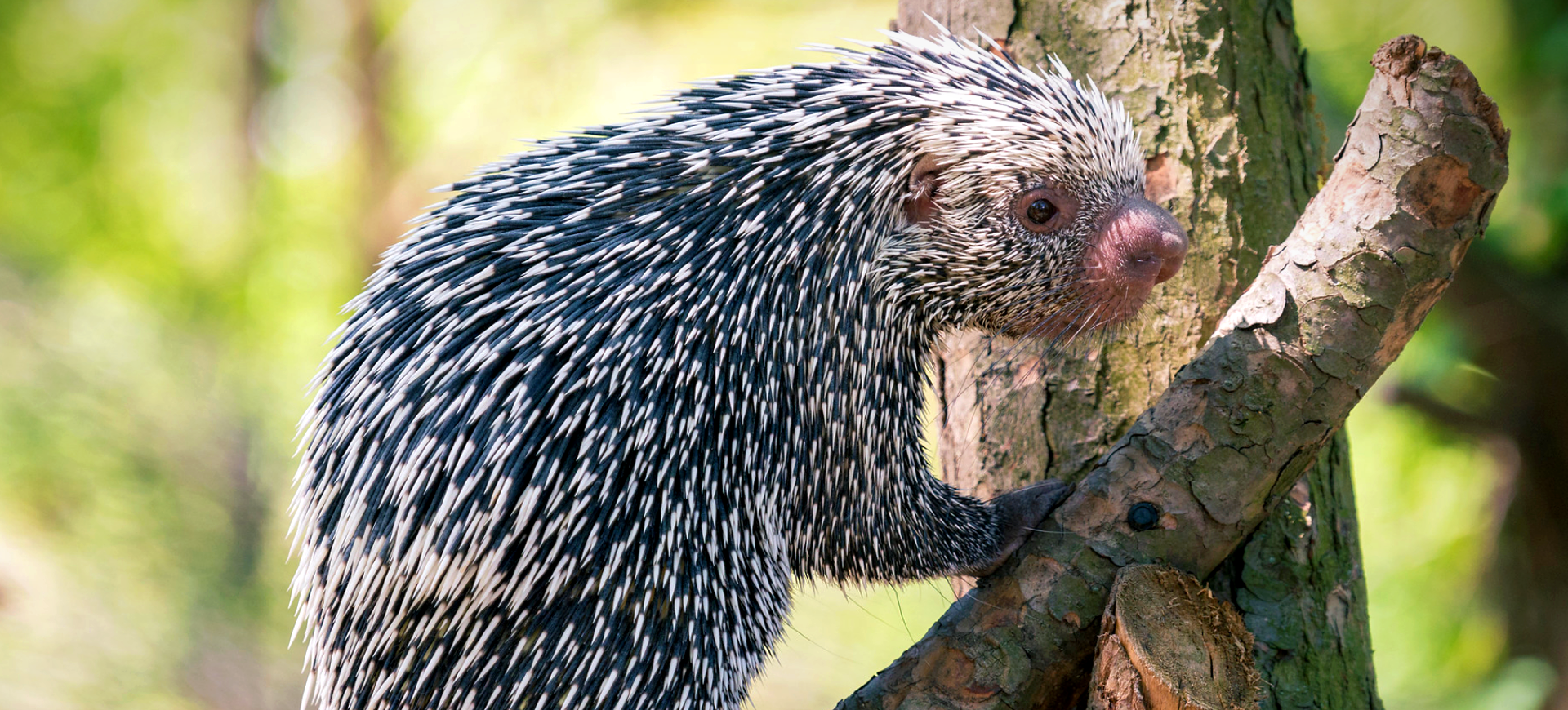Overview
The North American Porcupine is a large rodent native to North America, predominantly found in the United States, Canada, and Northern Mexico. It is primarily covered in long, bristle-like hairs and distinctive spines known as quills, which effectively defend against predators. The species has a notably rounded body, a small face, and short legs, making it well-suited for its often arboreal lifestyle. The quills that cover most of its body are modified hairs coated with thick plates of keratin, and they are sharp enough to penetrate the skin of predators upon contact.
Porcupines occupy a variety of habitats, not just limiting themselves to forests. They are highly adaptable creatures that can thrive in deserts, grasslands, and even tundra regions where vegetation is sparse. They are excellent climbers and are often seen perched high in trees, from where they can easily access food sources. These animals exhibit primarily nocturnal behavior, choosing to forage and explore during the cooler and safer night hours. Their adaptability to diverse environments and varied diets has made them resilient to other species’ challenges.
The North American Porcupine primarily subsists on an herbivorous diet, feeding mostly on a range of plant matter. They have a penchant for leaves, twigs, and bark, which they obtain from ground-level and elevated tree branches. Their large, curved incisors are perfectly adapted for gnawing on tough, woody plant material. These strong teeth are crucial for breaking down their fibrous diet, which often consists of tree bark in winter and a wider range of leaves and fruits during warmer seasons. This specialized dentition allows them to efficiently extract nutrients from plant materials that many other animals find indigestible.
Taxonomy
Kingdom
Phylum
Class
Order
Family
Genus
Species
Sub Species
Type
Physical Description:
The North American Porcupine is most notably characterized by its array of quills, reaching an average length of around 3 inches. These quills are hollow, allowing for buoyancy, and are barbed at the tips, which makes them particularly effective as a defense mechanism. The coloration of these quills can range widely, from shades of black and brown to lighter hues of white, making for a striking appearance. The body of the North American Porcupine is notably stout, contributing to its distinctive rounded shape. It also features a relatively small head in proportion to its body size, equipped with large, gnawing incisors essential for its herbivorous diet.
Adult North American Porcupines are relatively large compared to other rodent species, and there is a marked size difference between genders, with males generally being larger than females. The limbs of these porcupines are robust and muscular, which are adaptations that allow them to be excellent climbers. The soles of their feet possess a specialized, textured pad that helps them to grip onto the branches and bark of trees securely. Adding to their unique physical characteristics is a moderately long tail, which assists in balance and is covered in quills. This quill-covered tail can be used as an additional tool for defense, as the porcupine can swing it to deter predators effectively.

Lifespan: Wild: ~5 Years || Captivity: ~10 Years

Weight: Male: 18-35 lbs (8-16 kg) || Female: 12-25 lbs (5-11 kg)

Length: Male: 25-40 in (64-102 cm) || Female: 20-35 in (51-89 cm)

Top Speed: 2 mph (3.2 km/h)
Characteristic:
Native Habitat:
The North American Porcupine is found in various forested areas, from deciduous and mixed to coniferous forests. They can adapt to various environmental conditions and are even found in some desert areas, showcasing their remarkable ecological flexibility. This adaptability allows them to thrive in regions where other species might struggle for survival.
Aside from forests, they can also be seen in open areas like grasslands and tundra. Porcupines are highly adaptable creatures known for their ability to climb trees efficiently to find food or escape predators. Although they are skilled climbers, they are not exclusively arboreal and forage on the ground, demonstrating their versatility in finding food and navigating different types of terrain.
Climate Zones:
Biogeographical Realms:
Continents:
Countries:
Diet:
Diet & Feeding Habits:
The North American Porcupine primarily feeds on plant matter, including bark, leaves, and twigs. During the winter, when other food sources are scarce, they primarily focus on the inner bark of trees, sometimes causing noticeable damage to the trees they feed on. They also consume fruits and vegetables when available, rounding out a flexible diet depending on the season and available resources.
Porcupines are exceptionally well-adapted for foraging, utilizing various physical and sensory capabilities to find food. They use their keen sense of smell to locate potential food sources, even from a distance. Their strong jaws and specialized teeth are perfectly suited for chewing through tough plant materials like bark and woody twigs. During the warmer months, they may climb trees to access fresh leaves and twigs, using their climbing abilities to expand their dietary range.
Mating Behavior:
Mating Description:
The North American Porcupine has a relatively short mating season, usually occurring in late summer or early fall. During this time, males may become aggressive and engage in vocalizations, posturing, or even physical combat to compete for the attention of females. This heightened aggression is a temporary but distinct behavioral change to increase their chances of successful mating.
Once a male successfully courts a female, the mating process is brief and often lasts only a short time. After mating, the female is left to care for the offspring alone, as there is no evidence of paternal involvement in rearing the young. The gestation period lasts approximately seven months, and the female usually gives birth to a single offspring, which is born relatively well-developed compared to other rodents.
Reproduction Season:
Birth Type:
Pregnancy Duration:
Female Name:
Male Name:
Baby Name:
Social Structure Description:
North American Porcupines are generally solitary animals but may form small groups in winter to share dens for warmth and protection. While not territorial in the traditional sense, they do have frequent home ranges, which can sometimes overlap with those of other porcupines.
Social interactions among North American Porcupines are limited, but a certain hierarchy exists among males, particularly during the mating season when competition for females becomes intense. Communication between individuals is mainly facilitated through vocalizations, body postures, and quills rattling to convey various signals or emotions.
Groups:
Conservation Status:
Population Trend:
The North American Porcupine population is generally considered stable, with no immediate, large-scale threats endangering the species. It is not currently subject to significant threats such as hunting or predation. However, local populations can be affected by habitat destruction and road accidents, particularly in areas with high human activity.
While exact numbers are difficult to determine due to their wide distribution and secretive nature, the species is widespread and commonly encountered in suitable habitats. Localized efforts to control populations, often in response to tree damage or agricultural concerns, do not significantly impact their overall numbers, indicating a certain resilience to human intervention.
Population Threats:
The main threats to the North American Porcupine population include habitat loss and fragmentation, largely attributed to logging, agriculture, and urban development. While they are relatively adaptable creatures, significant habitat changes can be detrimental and lead to isolated populations, which may result in genetic bottlenecks.
Another concern is road accidents, as porcupines are slow-moving and often become victims of vehicular collisions, particularly in regions where roads intersect their natural habitats. They are also hunted and trapped for their quills, although this is less common today than in the past, thanks partly to increased awareness and conservation efforts.
Conservation Efforts:
Current conservation efforts primarily focus on habitat preservation and management, including initiatives to mitigate the impacts of logging and urban development. Local initiatives particularly target the protection of forested areas where porcupines are commonly found, ensuring these habitats remain suitable for sustaining healthy populations.
Education and awareness campaigns are also instrumental in reducing human-wildlife conflicts, such as tree damage caused by the porcupines’ feeding habits. While they are not considered an endangered species, maintaining the integrity of their habitats remains crucial for their long-term survival, and these educational efforts help foster a more harmonious coexistence between humans and porcupines.
Additional Resources:
Fun Facts
- North American Porcupines have around 30,000 quills.
- They are the second-largest rodent in North America after the beaver.
- Porcupines do not shoot their quills; they must make contact to embed them.
- They have a strong affinity for salt and may chew on wooden structures to obtain it.
- A baby porcupine is called a “porcupette.”
- Their skin has antibiotic properties to prevent infection when their quills stick to them.
- The Latin name “Erethizon dorsatum” translates to “animal with an aroused back.”
- Porcupines have been found at elevations of up to 12,000 feet.
- They are excellent swimmers, thanks to their hollow quills, which provide buoyancy.
- The porcupine’s digestive system harbors bacteria that break down tough plant materials.














